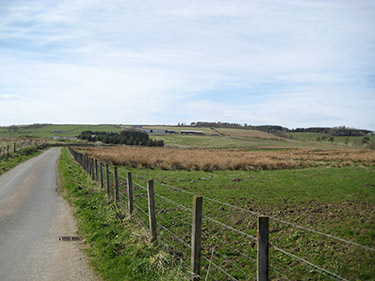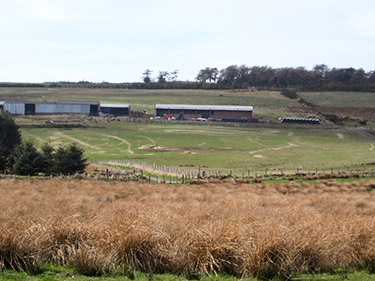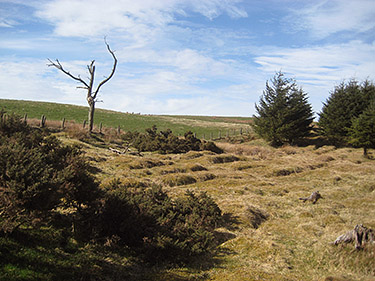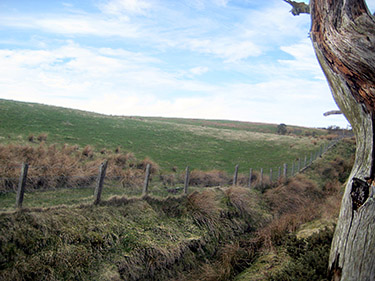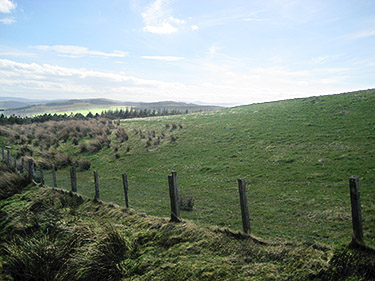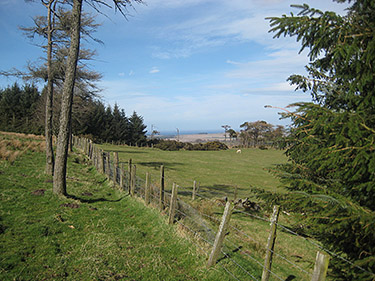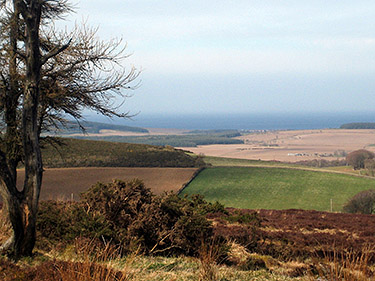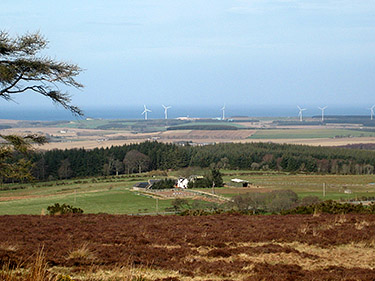|
The
Home Guard
Soon after the beginning of World War Two in
September 1939, most men who could fight, volunteered to
join the forces and those that were left were either too
young, too old, or in reserved occupations - jobs vital
to the war effort.
On 14 May 1940, when an invasion seemed
likely, the Government broadcast a message asking for
volunteers aged between 17 and 65, who were able to fire
a rifle or shotgun, to join the Local Defence Volunteers
(LDVs). By the end of June nearly one and a half
million men had been recruited and after the fall of
France in the same month, thousands of LDVs were
deployed along the British coast. In August of the same
year, Churchill changed the name of the LDV to the more
inspiring Home Guard.
In the early days, only one in ten men was armed with a rifle
(from the First World War). The public were invited to
give their shotguns and pistols to the Home Guard and
within a few months over 20,000 weapons were handed in.
However there were still not enough guns to go around
and the men carried pickaxes, crowbars, coshes, spears
and dummy rifles whilst on duty. Uniforms began arriving
in the autumn of 1940. Some got khaki serge battledress
whereas others had to wear armbands. |

Typical Home Guard Captain
or Zone Commander
|
|
The men were instructed on how to make Molotov cocktails that
could be used against German tanks during the expected
invasion and also trained in sabotage and the use of
high explosives.
The invasion never came, however, and the
main role of the Home Guard was capturing German airmen
whose planes had been shot down over Britain. They also
guarded munitions factories and aerodromes, organised
roadblocks, checked people's identity cards and helped
generally with civil defence.
The Home Guard was stood down in December 1944 and disbanded
on 31 December 1945. |
|
The
Aberchirder Home Guard
Jack Stewart joined the Local Defence
Volunteers or Home Guard at the age of 17. The unit was
run by an ex-Sgt Major, Bill Fordyce, and met twice a
week in the West Hall. Activities included square
bashing, body building, various sports and “Dad’s Army”
manoeuvres in the woods on Cleanhill.
The
members lived in Aberchirder and the surrounding rural
areas and were ‘key workers’ who were exempt from
joining up. They included:
John Coull and his son Harry – joiner and
undertaker
Jim Fraser – cycle agent
David Godsman – blacksmith and farrier
J & C Grant – builders who employed many
William Grant – solicitor
William McKay & Sons – engineers, motor mechanics, and
mobile threshing mills
David MacLennan – motor mechanic, car hire and filling
station
Bob Stevenson & his son Waldie – blacksmith and hearse
duties.
Other
exempt occupations were road maintenance, farm workers
and builders.
People below or above call-up age also joined.
This photograph would have been taken when
the Aberchirder unit was being inspected by the three
officers in the middle of the front row.
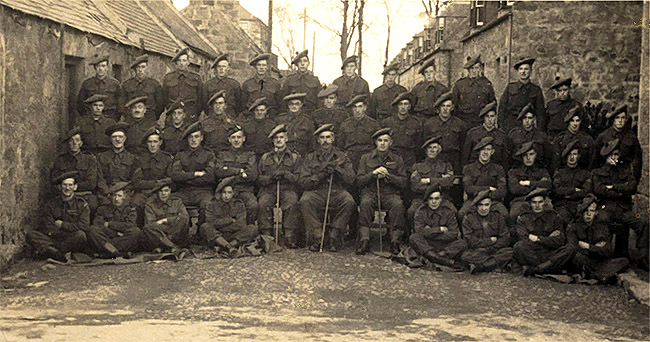
(Photo courtesy of Nancy McKidd)
Names identified are:
Back (l to r): X; Sandy Wilson (Littlefield,
late church beadle); X; John Morrison (Mains of Corskie?
Clunie?); X; Jimmy Thomson (Peterden); Sandy Inglis
(Aberchirder); X; Eric Wilson (son of Cody Wilson,
baker); John Stephen (Wester Corskie); J Steel (Barbank);
X.
2nd back (l to r): John Grant (Knockorth);
X; A Morrison, ‘Springies’ (Spring Garden); X; Jimmy
Sievwright (Cranna Bridge Croft); John Auchinachie
(Merchant, Aberchirder); X; Gordon (Gallowhill)?;
X; G Mitchell (Cranna); X; David Duncan (Aberchirder,
brother of Margaret Duncan); Willie Duguid (Bellman’s
Croft, Ord, cousin of the Cranna Duguids); X.
3rd back (l to r): J (Dodie?)
Bremner (Cornhill, worked at Auchinderran); Charles
Sandison (butcher, Aberchirder); Harold Geddes
(Aberchirder); Geordie Stephen (Mains of Auchinderran);
X; Three visiting officers?; Alex Watt (Castlebrae);
Bill Andrew (Aberchirder); X; X; X.
Front (l to r): X; Ian Leslie; X; X; Gordon
Raffan (Forglen, worked with John Fraser, cycle shop);
X; X; James Legge (Finnygaud). |
|
Auxiliary Units
In July 1940, Churchill set up the Special
Operations Executive (SOE) to conduct warfare in Europe
by organising espionage and sabotage behind enemy lines.
In its early days SOE also served as the core of the
Auxiliary Units, a British resistance movement which
would act in case of a German invasion.
These top-secret Auxiliary Units of six to
eight carefully selected men operated all over Britain –
estimated at about 3500 men in all. The units were especially
active here in the North East, which is why the area is
blessed with the remains of several secret bunkers and
bases. Patrol leaders were often schoolmasters, while
the bulk of recruits were farmers or farm workers, who
had the necessary detailed knowledge of their local
area. |
|
Although members of local Home Guard
platoons found their way into the Auxiliary Units there
was not really much contact at any level, although
some very senior Home Guard officers may have known
about the Auxiliary Units as some of their individuals
with the necessary qualities were being 'poached'.
The Intelligence Officer for the North East
of Scotland / Aberdeenshire was Capt. Reginald
Gordon-Lennox, who was from the Scots Guards and based
at Blairmore House at Glass near Huntly,
Pictured right:
Military personnel at Blairmore House 1942
(possibly Capt Gordon-Lennox in the car) |
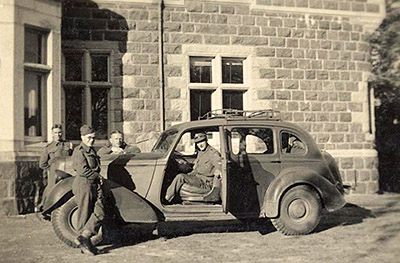
(Photo courtesy of Bob Munro) |
|
Local Auxiliary Units
Five months after
joining the Home Guard, Jack Stewart was approached by
Sgt Major Bill Fordyce and invited to join the Auxiliary
Unit.
He would get to know the facts later but it would save
him from being called up to the regular forces quite so
early. He agreed, but only found out what he was letting
himself in for after he had signed the Official Secrets
Act.
In fact, in the event of a Nazi invasion, he
was committed to going into hiding behind the enemy
lines to carry out sabotage and it was expected his
group would last no longer than a fortnight at most.
Once the Nazis had control of Norway,
parachute landings along the Moray Firth coast were
thought likely. Most local Auxiliary Units were
planned for being about seven miles from the coast, if
the site was suitable and near enough to strategic
points which could slow up the enemy after invasion. |
|

1940s Hand Grenade |
The purpose of the groups was to blow up
enemy convoys at night. The members were trained by the
Army to use hand grenades (throwing from lying on back
position), revolvers and rifles, Molotov cocktails,
sticky bombs and how to set booby traps. They examined
bridges to find the weakest points and practised using
explosives on trees and big stones.
The local groups were based at Culvie,
Bridge of Marnoch and Forglen. |
|
Local Auxiliary Unit members
What made Jack Stewart an ideal recruit was
that he worked in his father’s bakery and undertook van
deliveries, so he could drive and knew the area well. In
Jack’s time. other members of the Culvie group were Sgt
Major Bill Fordyce (Newton of Culvie, farmer), Gilbert
Brodie (Culvie Valley, joiner), George Cruickshank (Over
Culvie, farmer’s son), Bill Drummond (Finnygaud Croft,
farm worker), George Legge (Craigieview, farm worker)
and George McDonald (Windyedge, farmer).
Although Jack was a member
of the Culvie Bunker, he was also a driver for 2nd
Lt. Bonar Budge who was Head Teacher of Marnoch School
(1927-1943) and leader of the Marnoch and Forglen
groups. Jack visited the other bunkers with Lt Budge and
met some of the members. Of the Marnoch group Jack
recalls - Sgt W Main, Corporal Leslie Stephen (Euchrie,
farmer), Robert Wilson (Turtory, farmer), Robert Cumming
(Craighead, farmer), Andrew Sinclair (schoolmaster at
Easterfield) and the gravedigger, Duncan Munro.
The only Forglen
members Jack recalls were a gamekeeper and a maintenance
joiner.
Jack’s connection with the Auxiliary Unit
ended when he was called up to the RAF in August 1942.
John Morrison was sure the Culvie group continued
thereafter and recalls hearing loud explosions coming
from their Sunday practices when big boulders were used
as targets. Activities would have ended in 1944 when the
organisation was wound up nationally. |
|
High explosives group of the Home Guard at Aswanley 1942
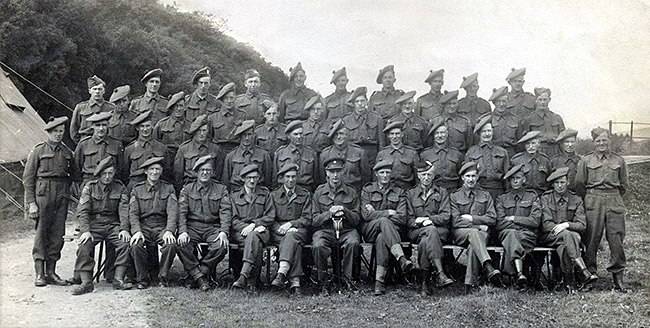
(Photo courtesy of Bob Munro)
Occasional weekend camps were organised at
Aswanley beside Blairmore, Members of the Culvie
and Marnoch units who have been identified are:
Back row from left: Jack Stewart (5th),
George McDonald, Windyedge (7th).
3rd row from left: James Legge,
Finnygaud (1st); George Stephen, Auchinderran
(4th); probably Bill Fordyce, Newton of
Culvie (7th); Robert Wilson, Turtory (8th);
Duncan Munro, Marnoch (far right).
Front row from left: 2nd
Lt A H Bonar Budge, Marnoch (4th); Capt
Gordon-Lennox (6th); Capt Cochrane (7th);
Corp Leslie Stephen, Euchrie (10th).
|
|
Members of auxiliary units at Blairmore

(Photo
courtesy of Alison Smith)
The group includes senior officers Capt
Cochrane, Capt Gordon-Lennox and Lt George Fisher (5th,
6th and 8th respectively in the 2nd
front row).
However the only member of the local units who has been
identified is Lt A H Bonar Budge (2nd from
right in 2nd front row).
|
|
Duncan Munro, Marnoch gravedigger
Bob Munro kindly provided photographs
featuring his grandfather Duncan, who was the
gravedigger at Marnoch Cemetery. He and his family lived
in the mort-house in the south-east corner of the
graveyard – built in 1822, originally to keep corpses
safe from body-snatchers! - the last family to do so.
Robert recalls that his grandfather never
spoke about the war as he was embarrassed at not having
been on active service like all his pals, despite the
fact that he had in fact volunteered to put his life in
peril but was sworn to secrecy.
|
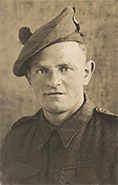
Duncan Munro |
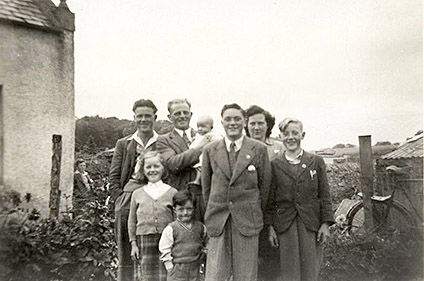
The Munro family at Marnoch Mort-house 9 September 1951
From
left: Albert, Kathleen, Duncan (Robert’s grandfather)
holding Sheena, Brian (front), Robbie (Robert’s father),
Kate (Robert’s grandmother), Erik. |
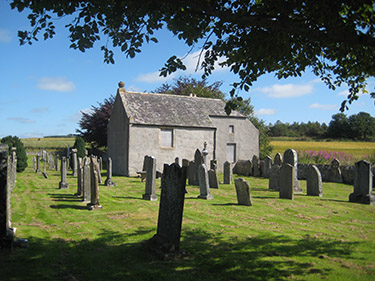
Marnoch Mort-house 2011
|
|
As an aside, Duncan Munro had a connection with a famous
wartime incident in the North-east involving the
‘Beautiful Spy’. He was a brother-in-law of P C Bob
Grieve, who in 1942 took part in the arrest of three
German spies at Portgordon railway station and later was
the star witness at their trial at the Old Bailey.
For
details see:
http://rgu-sim.rgu.ac.uk/history/German%20Spies.htm
http://rgu-sim.rgu.ac.uk/history/spies.htm
http://www.geocaching.com/seek/cache_details.aspx?guid=43f3d0d2-5676-43f1-bf39-43801cf37431&log=y&decrypt=
Right: Bob Grieve with family at Portgordon 1942
|
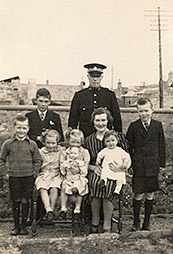 |
|
Underground bunkers
These were made by Royal Engineers, so
discreetly that some of the farmers on whose land they
were built didn’t know of their existence. The Culvie
bunker was near the top of Culvie Hill, the one at
Marnoch was built just below the graveyard and the
Forglen one in the Mountblairy woods just before the
river bank.
Right: A possible site for the Marnoch bunker,
between the cemetery wall and the river.
|
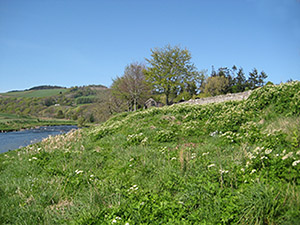 |
|
The
Culvie bunker
At Culvie, the bunker was built into the
heather-covered hillside, on land above Newton of Culvie
belonging to Culvie Estate and farmed by Bill Fordyce.
(Map ref 582 546.) John Morrison – who was a member of
the Cornhill Home Guard - recalls it was constructed in
a hollow where an old road metal quarry had probably
been.
The Auxiliary Unit uniform consisted of
black rubber boots and leggings, balaclavas and
blackened faces. In case of discovery, the men could
escape along a ditch, which was also convenient for
toilet needs. About 380 yards north of the bunker (map
ref 581 550) on Park Estate land farmed by Bremner of
Thorax, was a tree-house style lookout about 5 feet
square, situated on the hillside with a clear view over
the Greendykes road to Portsoy – seven miles distant -
and the coast. The lookout was connected to the bunker
by two wires which allowed the watchers to transmit by
Morse code to the men in the bunker. Usually there were
two lookouts and five inside the bunker.
|
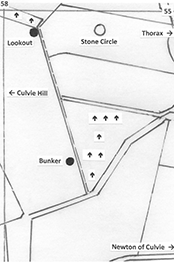 |
|
Bunker
construction
The bunker entrance was a box of heather with a rabbit
burrow type hole giving access to the keyhole. A step
ladder led down to the bunker which had brick built
walls lined with white painted 9-inch boards to make it
light, and was high enough to stand up in. Lil Anderson
remembers her father Gilbert Brodie lined the bunker
with corrugated iron which after the war was left lying
in the field after the bunker was dismantled.
There were two sets of bunks made with timber and
netting wire, a water container and a primus stove for
which the Sgt Major supplied the paraffin. Food had to
be pinched – eggs, snare rabbits, etc – and sometimes
Jack brought pies and various other perishable goods
from the bakery.
Jack Stewart confirmed the Culvie bunker was certainly
not as neat and tidy as this recreation shown on the
right.
|

A mock-up showing what
an Auxiliary Unit's
secret bunker would have looked like. |
----------------------------------------
|
Acknowledgements & Thanks
This account of the local Home Guard and
Auxiliary Units is based on reminiscences provided by a
number of people who were involved, directly or
indirectly, in the activities: Jack Stewart, John
Morrison, Lil Anderson, Gladys Prosser, Charlie Anderson
and Bingo Bremner.
Special thanks go to Jack, aged 88, for his
long reminiscence and to the late John, a relative
youngster of 85 who, on a day of foul weather, led our
local historian Bob Peden across dubby parks and barbed
wire fences to show him the location of the Culvie
secret bunker. Thanks to Helen Lyon for providing
contacts, information and advice.
Thanks also to Bob Munro for information
and materials relating to his grandfather and the
Marnoch area, and to others for their photographic
submissions.
Finally we are grateful for the research carried out by
Bob Peden, the information and comments
from David Blair, Scotland’s leading expert on Auxiliary
Units, and Alison Smith, whose excellent website
includes an account of their activities in the Deskford
area and much more – see
http://www.genegenie-scotland.co.uk/The_Banffshire_Guerrillas.pdf
|
Return to Home
Front
1 -
2 -
3
Home
Activities
Businesses/Services Community
Virtual
Museum
Gift Shop
Site Map
Contact
Us Guest Book
Foggie News
Links
Copyright © 2002 –
ADCA Aberchirder, North East Scotland.
|












